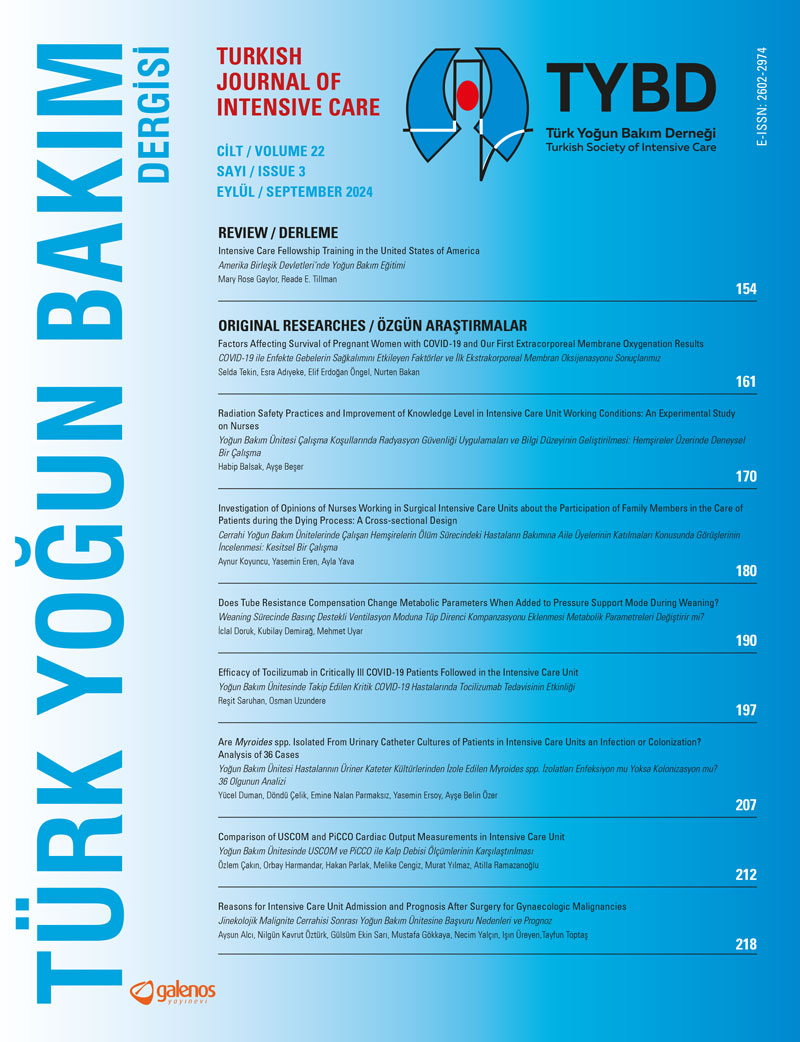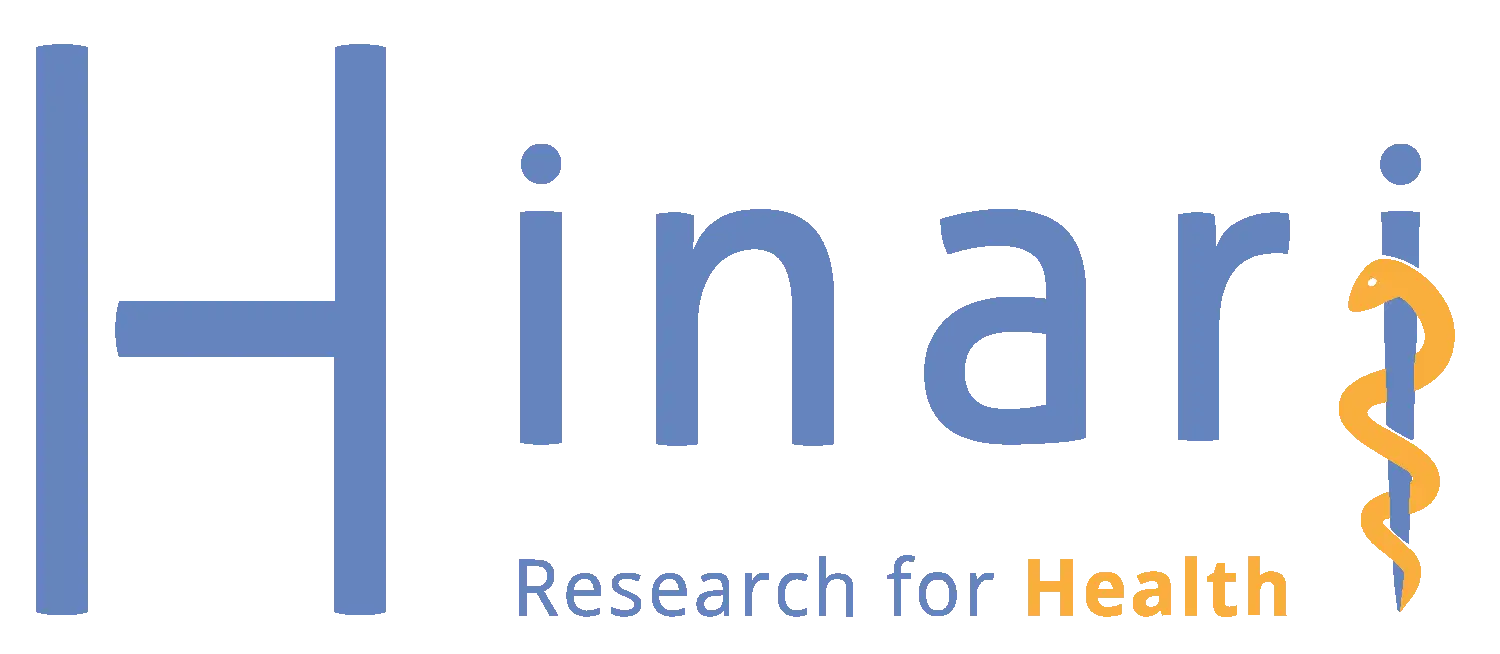Öz
Amaç
Bu çalışmanın amacı, yoğun bakım ünitelerinde (YBÜ) çalışan hemşirelere yönelik geliştirilen radyasyon güvenliği eğitiminin etkinliğini değerlendirmektir.
Gereç ve Yöntem
Bu çalışma iki farklı hastanenin yenidoğan ve çocuk YBÜ’lerinde çalışan toplam 144 hemşire üzerinde gerçekleştirilmiştir. Eğitim grubundaki hemşirelere (n=62) yoğun bakım hemşireleri için geliştirilen radyasyon güvenliği eğitimi 8-10 kişilik gruplar halinde 7 oturumda yüz yüze verildi. Veriler tanımlayıcı bilgi formu ve radyasyon güvenliği bilgi formu ile araştırmacı tarafından yapılan gözlemler aracılığıyla toplanmıştır.
Bulgular
Gözlemler sonucunda eğitim grubundaki hemşirelerin iyonize radyasyona karşı koruyucu davranış geliştirmeleri hem kontrol grubuna hem de eğitim öncesi duruma göre anlamlı olarak artmıştır (p<0,05). Eğitim grubundaki yoğun bakım hemşirelerinin radyasyon güvenliği bilgi düzeylerinin puan ortalamalarının önemli düzeyde belirlendi. Son gözlemlerde eğitim grubundaki hemşirelerin bazı kişisel koruyucu ekipman kullanımlarında anlamlı azalma olduğu belirlendi (p<0,05). Eğitim grubundaki hemşirelerin radyasyon güvenliği bilgi düzeylerinde zaman içinde sınırlı bir düşüş gözlendi.
Sonuç
Araştırma kapsamında uygulanan radyasyon güvenliği eğitiminin YBÜ’lerinde çalışan hemşirelerin radyasyon güvenliğinin sağlanmasında etkili bir yöntem olduğu sonucuna varılmıştır. YBÜ’ler de çalışanların doğru radyasyon güvenlik uygulamalarına sahip olmalarının çalışan sağlığı ve hasta güvenliğine olumlu katkı sunması beklenmektedir.
Anahtar Kelimeler: Hemşirelik, radyasyon, yoğun bakım ünitesi, eğitim, korunma
Referanslar
- World Health Organization. Communicating radiation risks in paediatric imaging: Information to support health care discussions about benefit and risk. World Health Organization; 2016. p. 11-2. Available from:URL:https://www.who.int/publications/i/item/978924151034
- Tang FR, Loganovsky K. Low dose or low dose rate ionizing radiation-induced health effect in the human. J Environ Radioact. 2018;192:32-47.
- Vano E, Sanchez RM, Fernandez JM. Strategies to optimise occupational radiation protection in interventional cardiology using simultaneous registration of patient and staff doses. J Radiol Prot. 2018;38:1077-88.
- Chang DS, Lasley FD, Das IJ, Mendonca MS, Dynlacht JR. Stochastic, Deterministic, and Heritable Effects (and Some Radiation Protection Basics). Basic Radiotherapy Physics and Biology. 2021:337-48.
- Preston DL., Kitahara CM, Freedman DM, Sigurdson AJ, Simon SL, Little MP, et al. Breast cancer risk and protracted low-to-moderate dose occupational radiation exposure in the US Radiologic Technologists Cohort, 1983-2008. Br J Cancer. 2016;115:1105-12.
- Azizova TV, Bragin EV, Hamada N, Bannikova MV. Risk of Cataract Incidence in a Cohort of Mayak PA Workers following Chronic Occupational Radiation Exposure. PLoS One. 2016;11:e0164357.
- Baselet B, Rombouts C, Benotmane AM, Baatout S, Aerts A. Cardiovascular diseases related to ionizing radiation: The risk of low-dose exposure (Review). Int J Mol Med. 2016;38:1623-41.
- Shabani F, Hasanzadeh H, Emadi A, Mirmohammadkhani M, Bitarafan-AR, Abedelahi A, et al. Radiation Protection Knowledge, Attitude, and Practice (KAP) in Interventional Radiology. Oman Med J. 2018;33:141-7.
- Ditkofsky N, Shekhani HN, Cloutier M, Chen ZN, Zhang C, Hanna TN. Ionizing Radiation Knowledge Among Emergency Department Providers. J Am Coll Radiol. 2016;13:1044-9.
- Carpeggiani C, Kraft G, Caramella D, Semelka R, Picano E. Radioprotection (un)awareness in cardiologists, and how to improve it. Int J Cardiovasc Imaging. 2012;28:1369-74.
- Jindal T. The Knowledge of Radiation and the Attitude Towards Radio-Protection among Urology Residents in India. J Clin Diagn Res. 2015;9:JC08-11.
- Balsak H, Güneş G, Ulutaşdemir N. Knowledge, Attitude and Behavior of Radiology Professionals about the Harmful Effects of Radiation Which is Used for Diagnosis. 2016;2:31-51.
- Jacob K, Vivian G, Steel JR. X-ray dose training: are we exposed to enough? Clin Radiol. 2004;59:928-34.
- Alotaibi M, Saeed R. Radiology nurses’ awareness of radiation. Elsevier. 2006;25:7-12.
- Dauer LT, Kelvin JF, Horan CL, st. Germain J. Evaluating the effectiveness of a radiation safety training intervention for oncology nurses: A pretest - intervention - posttest study. BMC Med Educ. 2006;6:32.
- Xie Z, Liao X, Kang Y, Zhang J, Jia L. Radiation Exposure to Staff in Intensive Care Unit with Portable CT Scanner. Biomed Res Int. 2016;2016:5656480.
- Divatia JV, Bhowmick K. Complications of endotracheal intubation and other airway management procedures. Indian J Anaesth. 2005;49:308-18.
- Ohno K, Kaori T. Effective education in radiation safety for nurses. Radiat Prot Dosimetry. 2011;147:343-5.
- Kim O, Kim MS, Jang HJ, Lee H, Kang Y, Pang Y, et al. Radiation safety education and compliance with safety procedures-The Korea Nurses’ Health Study. J Clin Nurs. 2018;27:2650-60.
- Morishima Y, Chida K, Katahira Y, Seto H, Chiba H, Tabayashi K. Need for radiation safety education for interventional cardiology staff, especially nurses. Acta Cardiol. 2016;71:151-5.
- Needham G, Grimshaw J. Guidelines for healthcare professionals who prescribe imaging investigations involving ionising radiation. European Commission, 2008. p.383-98. Available from: URL:https://www.sergas.es/docs/profesional/boapraticaclinica/rp118.pdf
- Valentin J. The 2007 recommendations of the International Commission on Radiological Protection. Ann ICRP. 2007. p.103. Available from: URL:https://icrp.org/docs/ICRP_Publication_103-Annals_of_the_ICRP_37(2-4)-Free_extract.pdf
- Bennett GF. International basic safety standards for protection against ionizing radiation of and for the safety of radiation sources. Journal of Hazardous Materials. 1996;45:282.
- McGovern PM, Vesley D, Kochevar L, Gershon RRM, Rhame FS, Anderson E. Factors affecting universal precautions compliance. J Bus Psychol. 2000;15:149-61.
- Menzel HG, Harrison J. Effective dose: a radiation protection quantity. Ann ICRP. 2012;41:117-23.
- Friis RH. Occupational Health and Safety for the 21st Century. Burlington: Jones & Bartlett Publishers; 2014.
- Kang J, O’Donnell JM, Colaianne B, Bircher N, Ren D, Smith KJ. Use of personal protective equipment among health care personnel: results of clinical observations and simulations. Am J Infect Control. 2017;45:17-23.
- Levin PF. Test of the Fishbein and Ajzen models as predictors of health care workers’ glove use. ResNurs Health. 1999;22:295-307.
- Flôr R de C, Gelbcke FL. Radiation protection and the attitude of nursing staff in a cardiac catherization laboratory. Texto & Contexto-Enfermagem. 2013;22:416-22.
- Tanrıverdi H, Akova O, Latifoğlu NT. Yenidoğan Yoğun Bakım Ünitelerinde İş Kazaları Riskleri Ve Nedenlerine Yönelik Bir Araştırma. Business & Management Studies: An International Journal. 2015;3:234-60.
- Ayatollahi J, Ayatollahi F, Ardekani AM. Occupational hazards to dental staff. Dent Res J (Isfahan). 2012;9:2.
- Ünal ES, Geliş K, Baykan P. Investigation of awareness levels about the radiation safety of personnel working in the imaging units of the hospitals in Agri, Turkey. J Radiat Res Appl Sci. 2018;11:111-5.
- Azimi H, Majd Teimouri Z, Mousavi S, Kazem Nezhad Leyli E, Jafaraghaee F. Individual protection adopted by ICU nurses against radiation and its related factors. J Holist Nurs. 2018;28:18-25.
- Huda W. Radiation doses and risks in chest computed tomography examinations. Proc Am Thorac Soc. 2007;4:316-20.
Telif hakkı ve lisans
Telif hakkı © 2024 Yazar(lar). Açık erişimli bu makale, orijinal çalışmaya uygun şekilde atıfta bulunulması koşuluyla, herhangi bir ortamda veya formatta sınırsız kullanım, dağıtım ve çoğaltmaya izin veren Creative Commons Attribution License (CC BY) altında dağıtılmıştır.






















